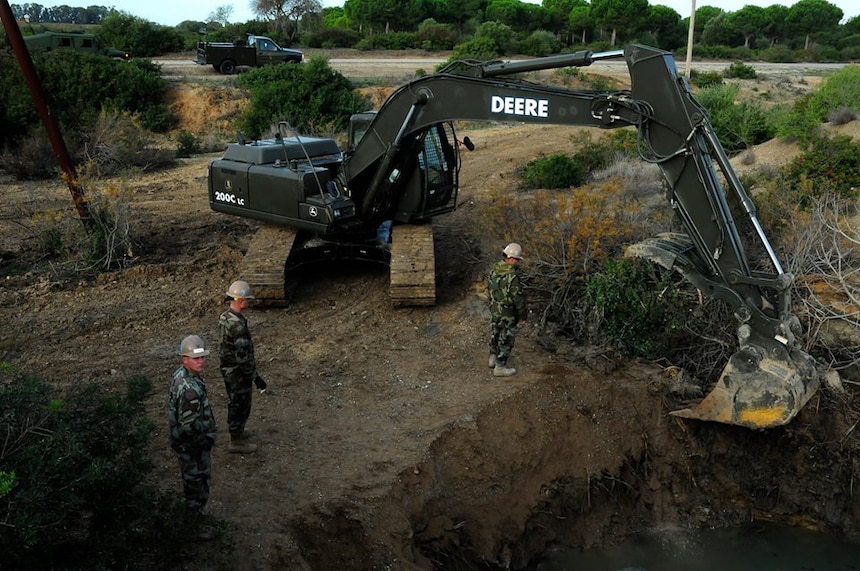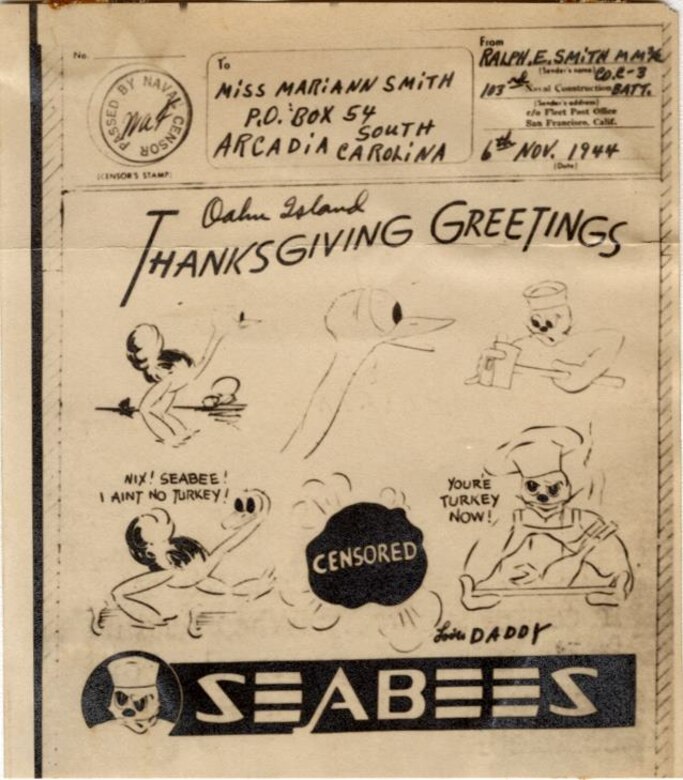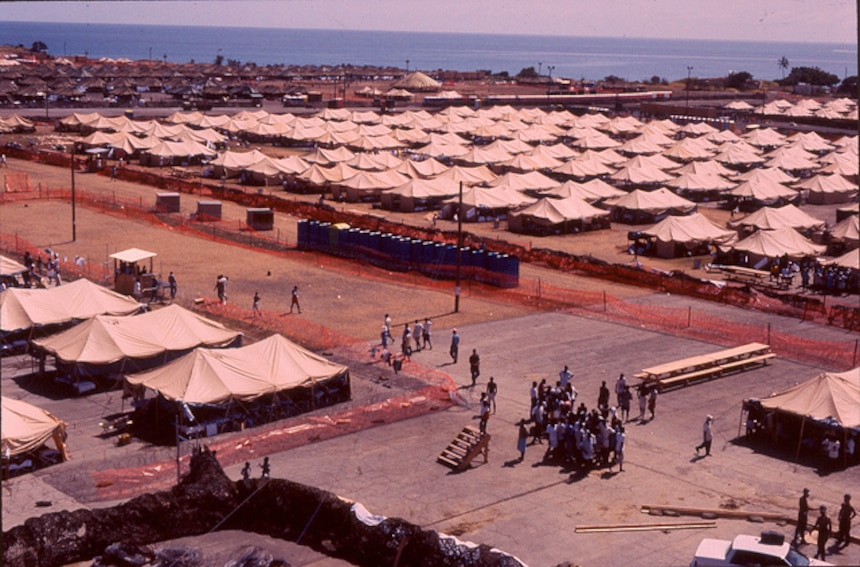Consolidated by U.S. Navy Seabee Museum, Naval History and Heritage Command
November 27
1943: 141st Naval Construction Battalion (NCB) commissioned at Naval Construction Training Center (NCTC) Camp Endicott, Davisville, Rhode Island.
Nov. 27-Dec. 7, 1967: Naval Mobile Construction Battalion (NMCB) 5 main body arrived Dong Ha, Republic of Vietnam (RVN).
1970: Seabee Teams 0108 and 0109 departed Davisville, Rhode Island, for reassignment to officer in charge (OIC), Construction Battalion U.S. Pacific Fleet Detachment (CBPACDET), Guam and deployment to Palau and Kusaie, Trust Territory of the Pacific Islands (TTPI), respectively. [caption id="attachment_17538" align="alignnone" width="763"]
 2009:
2009: Seabees from Naval Mobile Construction Battalion (NMCB) 3 operated an excavator to remove trash and brush from a natural spring at Naval Station Rota Spain. NMCB-3 restored the spring as part of an environmental rejuvenation project, which was requested by the Spanish Navy. (Courtesy of U.S. Navy Seabee Museum) [caption id="attachment_17536" align="alignnone" width="638"]

"Thanksgiving Greetings", V-mail, 6 November 1944. Seabee artists created stock V-mail messages that were used to send messages home. The messages were then filmed, sent home, and then printed back to paper upon arrival. V-mail was created to ensured that thousands of tons of shipping space could be reserved for war materials. The 37 mail bags required to carry 150,000 one-page letters could be replaced by a single mail sack. The weight of that same amount of mail was reduced dramatically from 2,575 pounds to a mere 45 lbs. (Courtesy of U.S. Navy Seabee Museum)
November 28
1945: 24th, 40th, and 68th NCBs inactivated on Okinawa. Section I of 106th NCB inactivated at Ie Shima.
2001: First members of NMCB 133 arrived a Camp Rhino, Afghanistan, during Operation Enduring Freedom.
November 29
1945: 46th Naval Construction Regiment (NCR) inactivated.
1967: NMCB 11 main body begins deployment from Dong Ha, RVN to Construction Battalion Center (CBC) Port Hueneme, California. The movement was accomplished by 14 Military Airlift Command (MAC) C-130 flights.
November 30
1942: The first echelon of the 29th NCB arrived at Rosneath, Scotland. These men were the first Seabees to land in Europe; 41st NCB commissioned at Camp Allen, Norfolk, Virginia.
1945: 12th Naval Construction Brigade inactivated. 54th NCR inactivated. 25th NCB inactivated on Guam. 79th and 82nd NCBs inactivated on Okinawa. 27th Special NCB inactivated on Okinawa.
1967: NMCB 5 relieved NMCB 11 at Camp Barnes, Dong Ha, RVN.
 Seabees constructed tent city as part of Operation Sea Signal. Joint Task force 160 constructed facilities to improve the quality of life of migrants at Guantanamo Bay, Cuba, December 1994. (Photo courtesy of U.S. Navy Seabee Museum)
Seabees constructed tent city as part of Operation Sea Signal. Joint Task force 160 constructed facilities to improve the quality of life of migrants at Guantanamo Bay, Cuba, December 1994. (Photo courtesy of U.S. Navy Seabee Museum)
Throughout December
1994: The main effort in Cuba was Operation "Sea Signal" during which Joint Task Force 160 constructed facilities to improve the quality of life of Cuban migrants at Guantanamo. By order of the 2nd Naval Construction Brigade, the 22nd Naval Construction Regiment (Forward Element) deployed to Guantanamo with Naval Mobile Construction Battalion 4 and an air detachment from Naval Mobile Construction Battalion 7. As directed by the U.S. Atlantic Command, the senior leadership of the 22nd Naval Construction Regiment (Forward Element) met with engineers from the Naval Facilities Engineering Command's Atlantic Division to develop preliminary designs for the $35 million Quality of Life Improvement Program for 20,000 Cuban migrants. The original plan called for the construction of 37 migrant villages arranged in 11 village clusters at two locations: Radio Range and McCalla Field, approximately seven miles apart. Migrant riots in Panama led to a decision to return 7,000 refugees to Guantanamo Bay; this resulted in both an accelerated construction schedule and an enlargement of project scope for the Seabees. A detachment from the Air Force's 820th Red Horse construction unit was mobilized from Nellis Air Force Base to assist the Seabees. When the project concluded the two tent cities constructed were capable of housing almost 20,000 people. This multi-national, joint-service work-force completed an astonishing 100,000 man-days of construction effort in a harsh environment while scheduling their construction projects around the migrants and their daily operations.
December 1
1944: 108th NCB inactivated in Davisville, Rhode Island.
1945: 11th NCB inactivated at Subic Bay, Philippines. 37th NCB inactivated at Okinawa. 104th NCB inactivated at Samar, Philippines. 18th Special NCB inactivated on Peleliu. 23rd Special NCB inactivated at Okinawa.
1966: NMCB 8 main body of 19 officers and 707 enlisted personnel begin deployment by air from CBC, Port Hueneme, California to Rosemary Point, Chu Lai, RVN.
1967: Main body of NMCB 1 arrived at Davisville, Rhode Island from Da Nang, RVN. The commanding officer of NMCB 5 relieved the commanding officer of NMCB 11 as commanding officer of Camp Barnes, RVN.
1968: Seabee Team 0913 completed training at the 31st NCR and deployed to RVN, on a C-118 aircraft from Naval Air Station (NAS) Point Mugu, California.
December 2
1942: 44th NCB commissioned at Camp Bradford, Norfolk, Virginia. 51st NCB commissioned at Camp Endicott, Davisville, Rhode Island.
1945: 32nd NCR inactivated.
1966: A change of command ceremony was held on board Camp Haskins, Da Nang, RVN at which Cmdr. Daniel N. Shockey relieved Cmdr. Richard E. Anderson as commanding officer of NMCB 9.
1966: Seabee Team 0509 deployed to Vietnam.
1968: NMCB 9 main body, consisting of 14 officer and 499 men, deployed to Camp Kinser, Okinawa, on two 707s and one Super DC-8 from NAS Point Mugu, California.
Dec. 2 & Dec. 5, 1946: The USS Yancey and USS Merrick, respectively, departed Port Hueneme, California to take part in Admiral Richard E. Byrd s Antarctic expedition, Operation Highjump. Aboard these ships were 166 Seabee members of the expedition. The mission of Operation Highjump was to map the frozen continent, train personnel, and test gear under cold weather conditions. Seabee tasks at Little American Four included unloading equipment and supplies, setting up a temporary naval base, and building housing, a mess hall and storage facilities. In addition, they built a temporary airstrip, an emergency base further inland, and a communications system. These men were the first Seabees to serve in Antarctica.
1969: The main body of NMCB 4 moved from Vietnam to CBC, Port Hueneme, California.
December 3
1945: 98th NCB inactivated at Sasebo, Japan. 135th NCB inactivated at Okinawa.
1945: 25th Special NCB inactivated at Milne Bay.
1966: NMCB 74 recommissioned at ceremony at CBC Gulfport, Mississippi, with Cmdr. Gordon W. Schley.
1966: NMCB 3 begins departure from Chu Lai, RVN on eight C-141 aircraft.
1971: Lt. Cmdr. D. Plunnecke was relieved as executive officer of NMCB 74 by Lt. Cmdr. S.J. Quigley.